Some daily sky sights among the ever-changing Moon, planets, and stars.
Comet Lovejoy is still 5th magnitude, high in the evening sky for binoculars and telescopes. See Comet Lovejoy Shines On.
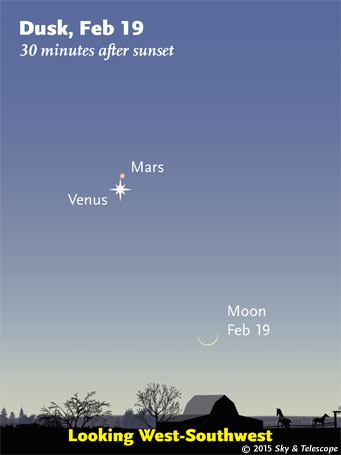
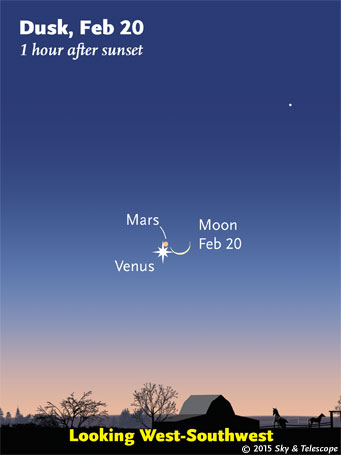
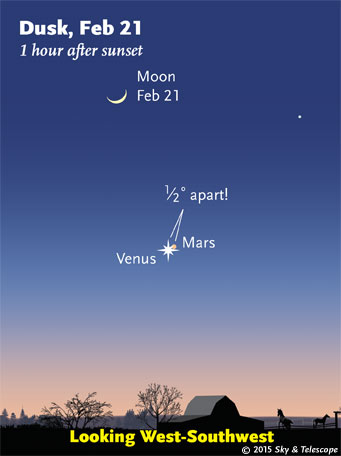
Friday, February 13
After dusk at this time of year, four carnivore constellations climb upward low in a row across the northeast to southeast. They're all seen in profile, with their noses pointed to the upper right and their feet (if any) to the right: Ursa Major in the northeast with the Big Dipper as its brightest part, Leo in the east, Hydra the Sea Serpent in the southeast (Jupiter shines midway between the heads of Leo and Hydra), and Canis Major in the south.
Saturday, February 14
Zenith star. If you're in the world's mid-northern latitudes, bright Capella passes straight overhead, or nearly so, around 7 or 8 p.m. (depending on how far west or east you are in your time zone). It goes exactly through your zenith if you're at latitude 46° north: for example Portland, Oregon; Montreal; central France.
And whenever Capella passes highest, Rigel in Orion's foot is always due south.
Sunday, February 15
Mid-February is when Orion stands highest in the south after dinnertime. His eastern shoulder, orange-red Betelgeuse, forms the Winter Triangle with brilliant Sirius far below and Procyon to their left.
Monday, February 16
The Winter Triangle, or rather one side of it, is also part of a much bigger asterism: the Winter Hexagon. This fills the sky toward the southeast and south these nights. Start with brilliant Sirius at its bottom. Going clockwise from there, march through Procyon, Pollux and Castor, Capella very high, Aldebaran over to Capella's lower right, down to Rigel in Orion's foot, and back to Sirius.
The eclipsing variable star Algol will be at its minimum light, magnitude 3.4 instead of its usual 2.1 (in other words a third of its normal brightness) for a couple hours centered on 12:19 a.m. Tuesday morning EST (9:19 p.m. Monday evening PST). Algol takes several additional hours to fade and to rebrighten.
Tuesday, February 17
Mars is now just 2° above Venus in the west-southwest at dusk. They'll remain at least this close for the next nine days.
The shadow of Jupiter's moon Io crosses Jupiter's face from 6:13 to 8:31 p.m. EST. It's following along sixteen minutes behind Io itself, which is less visible. Around 9:10 p.m. EST, Callisto disappears into occultation behind Jupiter's western limb. Then from 10:35 p.m. to 1:30 a.m. EST Europa's shadow crosses Jupiter, following thirty-five minutes behind Europa itself.
And, Jupiter's Great Red Spot comes into view around the planet's celestial eastern edge by midnight EST, to reach the planet's central meridian around 1:47 a.m. EST.
Wednesday, February 18
Juno, the 3rd-discovered asteroid, was at opposition three weeks ago but is now better placed for evening viewing. It's a little west of the head of Hydra (which is west of Jupiter) and magnitude 8.5. With your telescope, work your way to its exact position using the chart in the February Sky & Telescope, page 50.
Thursday, February 19
Algol is at its minimum light for a couple hours centered on 9:17 p.m. EST.
Mutual eclipse among Jupiter's moons. Io casts its shadow onto Ganymede from 7:35 to 7:43 p.m. EST this evening, dimming it by 0.8 magnitude — that is, reducing its brightness by half — at the middle of that time.
Friday, February 20
Venus, the thin crescent Moon, and little Mars form a tight bunch in the west-southwest during and after dusk, as shown above. They fit in a circle just 2° across at the times of dusk for most of North America.
Saturday, February 21
Venus and Mars are in conjunction 0.4° apart at dusk, with the Moon now looking on from on high, as shown above.
Want to become a better astronomer? Learn your way around the constellations. They're the key to locating everything fainter and deeper to hunt with binoculars or a telescope.
This is an outdoor nature hobby; for an easy-to-use constellation guide covering the whole evening sky, use the big monthly map in the center of each issue of Sky & Telescope, the essential guide to astronomy. Or download our free Getting Started in Astronomy booklet (which only has bimonthly maps).

Once you get a telescope, to put it to good use you'll need a detailed, large-scale sky atlas (set of charts). The standards are the little Pocket Sky Atlas, which shows stars to magnitude 7.6; the larger and deeper Sky Atlas 2000.0 (stars to magnitude 8.5); and once you know your way around, the even larger Uranometria 2000.0 (stars to magnitude 9.75). And read how to use sky charts with a telescope.
You'll also want a good deep-sky guidebook, such as Sue French's Deep-Sky Wonders collection (which includes its own charts), Sky Atlas 2000.0 Companion by Strong and Sinnott, the bigger Night Sky Observer's Guide by Kepple and Sanner, or the beloved if dated Burnham's Celestial Handbook.
Can a computerized telescope replace charts? Not for beginners, I don't think, and not on mounts and tripods that are less than top-quality mechanically (able to point with better than 0.2° repeatability, which means fairly heavy and expensive). As Terence Dickinson and Alan Dyer say in their Backyard Astronomer's Guide, "A full appreciation of the universe cannot come without developing the skills to find things in the sky and understanding how the sky works. This knowledge comes only by spending time under the stars with star maps in hand."
This Week's Planet Roundup
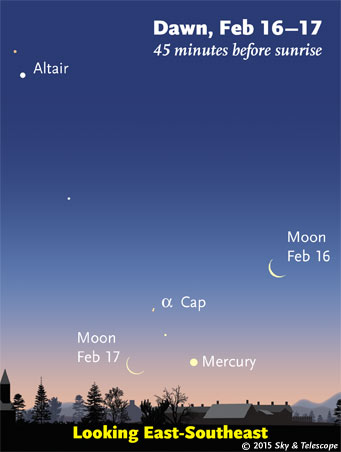
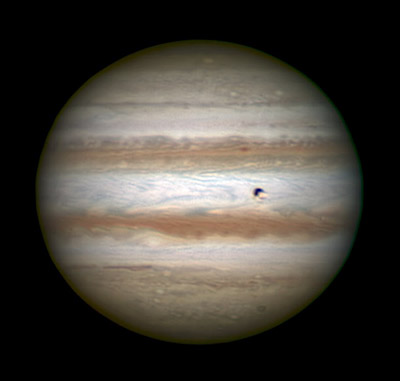
Mercury (about magnitude +0.2) is becoming visible before sunrise. Look for it just above the east-southeast horizon in early dawn. As the sky brightens, you'll need binoculars.
Venus (magnitude –3.9) and Mars (less than 1% as bright, at magnitude +1.2) are drawing close together in the west-southwest during evening twilight. The gap between them diminishes this week from 4° on the 13th (when Mars is on top) to 0.4° at their conjunction on the evening of Saturday the 21st (with Mars just to Venus's upper right). On Friday the 20th, the crescent Moon joins them to make a beautiful bunch.
Jupiter (magnitude –2.6, at the Leo-Cancer border) was at opposition last week. Watch for it coming into view in the east as twilight fades. As night falls, look to its left and lower left for the Sickle of Leo. By 7 or 8 p.m. Jupiter is high enough in the east for good telescopic viewing. By 10 p.m. it's essentially as high as it will get. In a telescope, Jupiter is a big 45 arcseconds across at its equator.
Saturn (magnitude +0.5, at the head of Scorpius) rises around 1 or 2 a.m. It's best placed fairly high in the south as dawn begins. A little more than 1° to Saturn's lower right in early dawn is Beta Scorpii, magnitude 2.5, a showpiece double star for telescopes. Below Saturn by 9° is orange Antares.
Uranus (magnitude 5.8, in Pisces) is getting low in the west right after dusk.
Neptune is hidden in the glare of the Sun.
___________________________
All descriptions that relate to your horizon — including the words up, down, right, and left — are written for the world's mid-northern latitudes. Descriptions that also depend on longitude (mainly Moon positions) are for North America.
Eastern Standard Time (EST) is Universal Time (UT, UTC, or GMT) minus 5 hours.
“This adventure is made possible by generations of searchers strictly adhering to a simple set of rules. Test ideas by experiments and observations. Build on those ideas that pass the test. Reject the ones that fail. Follow the evidence wherever it leads, and question everything. Accept these terms, and the cosmos is yours.”
— Neil deGrasse Tyson, 2014.
 1
1








Comments
Tom Hoffelder
February 13, 2015 at 8:52 pm
The 19th through the 21st presents some serious solar system sights. In addition to those noted, Europa eclipses Io from 9:42 to 9:48 EST on the 21st, plus the two are involved in an occultation from 9:04 to 9:11, as are Io and Ganymede from 6:48 to 6:54 on the 19th. Also on the 19th, 20th and 21st, Comet Lovejoy is less than one degree away from M76.
You must be logged in to post a comment.
You must be logged in to post a comment.